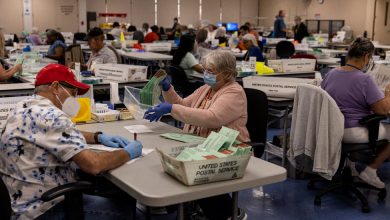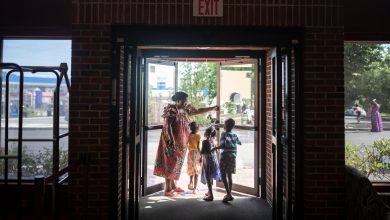Oath Keepers Leader Charged With Seditious Conspiracy in Jan. 6 Investigation

Stewart Rhodes, the leader and founder of the far-right Oath Keepers militia, was arrested on Thursday and charged with seditious conspiracy for organizing a wide-ranging plot to storm the Capitol last Jan. 6 and disrupt the certification of Joseph R. Biden Jr.’s electoral victory, federal law enforcement officials said.
The arrest of Mr. Rhodes was a major step forward in the sprawling investigation of the Capitol attack and the case marked the first time that prosecutors had filed charges of sedition. According to his lawyer, Jonathon Moseley, Mr. Rhodes was arrested at shortly before 1 p.m.
Mr. Rhodes, a former Army paratrooper who went on to earn a law degree at Yale, has been under investigation for his role in the riot since at least last spring when, against the advice of his lawyer, he sat down with F.B.I. agents for an interview in Texas. He was at the Capitol on Jan. 6, communicating by cellphone and a chat app with members of his team, many of whom went into the building. But there is no evidence that he entered the Capitol.
The Oath Keepers, along with the Proud Boys, have emerged as the most prominent far-right extremists to have taken part in the assault on the Capitol. Prosecutors have collected reams of evidence against them, including encrypted cellphone chats and recordings of online meetings. They have charged its members not only with forcing their way into the building in a military-style “stack,” but also with stationing an armed “quick reaction force” at a hotel in Virginia to be ready to rush into Washington if needed.
Through their lawyers, members of the Oath Keepers who are already facing charges have said they converged on Washington just before Jan. 6 as part of a security detail hired to protect conservative celebrities like Roger J. Stone, Jr., the longtime ally of former President Donald J. Trump.
Understand the Jan. 6 Investigation
Both the Justice Department and a House select committee are investigating the events of the Capitol riot. Here’s where they stand:
- Inside the House Inquiry: From a nondescript office building, the panel has been quietly ramping up its sprawling and elaborate investigation.
- Criminal Referrals, Explained: Can the House inquiry end in criminal charges? These are some of the issues confronting the committee.
- First Sedition Charges: In a major step forward in the Justice Department’s investigation, the F.B.I. arrested the leader of the Oath Keepers, charging him with seditious conspiracy.
- Garland’s Remarks: Facing pressure from Democrats, Attorney General Merrick Garland vowed that the Justice Department would pursue its inquiry into the riot “at any level.”
In an interview with The New York Times this summer, Mr. Rhodes expressed frustration that several members of his group had “gone off mission” by entering the Capitol on Jan. 6, quickly adding, “There were zero instructions from me or leadership to do so.”
But at least four Oath Keepers who were at the Capitol that day and are cooperating with the government have sworn in court papers that the group intended to breach the building with the goal of obstructing the final certification of the Electoral College vote.
Mr. Rhodes has also attracted the attention of the House select committee investigating Jan. 6, which issued him a subpoena in November. In a letter at the time, House investigators noted that Mr. Rhodes had taken part in several events intended to question the integrity of the 2020 presidential election throughout that fall and winter.
On Election Day, according to the letter, Mr. Rhodes said that an “honest” count of the votes could only result in a victory for Mr. Trump and called on members of his group to “stock up on ammo” and prepare for a “full-on war in the streets.”
Within a week of Election Day, Mr. Rhodes had told the conspiracy theorist Alex Jones that he had men stationed outside Washington prepared to act at Mr. Trump’s command.
Around the same time, federal prosecutors say, he urged his fellow Oath Keepers at an online meeting to support Mr. Trump, calling him the “duly elected president” and adding: “You can call it an insurrection or you can call it a war or fight.”
The drumbeat continued through the winter, prosecutors say, as Mr. Rhodes appeared at a pro-Trump rally in Washington on Dec. 12, 2020, and called on Mr. Trump to invoke the Insurrection Act, suggesting that a failure to do so would result in a “much more bloody war.” At the rally, Mr. Rhodes acknowledged in a television interview that he and members of his group were there to provide security for celebrity speakers along with another shadowy paramilitary organization, the First Amendment Praetorian.
On Jan. 4, just two days before the storming of the Capitol, Mr. Rhodes posted an article on the Oath Keepers website calling on “all patriots” to “stand tall in support of President Trump’s fight to defeat the enemies foreign and domestic who are attempting a coup.”
Key Figures in the Jan. 6 Inquiry
The House investigation. A select committee is scrutinizing the causes of the Jan. 6 riot at the U.S. Capitol, which occurred as Congress met to formalize Joe Biden’s election victory amid various efforts to overturn the results. Here are some key figures in the inquiry:
Donald Trump. The former president’s movement and communications on Jan. 6 appear to be a focus of the inquiry. But Mr. Trump has attempted to shield his records, invoking executive privilege. The dispute is making its way through the courts.
Kevin McCarthy. The panel has requested an interview with the House Republican leader about his contact with Mr. Trump during the riot. The California representative, who could become speaker of the House after the midterms in November, has refused to cooperate.
Mike Pence. The former vice president could be a key witness as the committee focuses on Mr. Trump’s responsibility for the riot and considers criminal referrals, but Mr. Pence reportedly has not decided whether to cooperate.
Mark Meadows. Mr. Trump’s chief of staff, who initially provided the panel with a trove of documents that showed the extent of his role in the efforts to overturn the election, is now refusing to cooperate. The House voted to recommend holding Mr. Meadows in criminal contempt of Congress.
Scott Perry and Jim Jordan. The Republican representatives of Pennsylvania and Ohio are among a group of G.O.P. congressmen who were deeply involved in efforts to overturn the election. Both Mr. Perry and Mr. Jordan have refused to cooperate with the panel.
Fox News anchors. Texts between Sean Hannity and Trump officials in the days surrounding the riot illustrate the host’s unusually elevated role as an outside adviser. Mr. Hannity, along with Laura Ingraham and Brian Kilmeade, also texted Mr. Meadows as the riot unfolded.
Steve Bannon. The former Trump aide has been charged with contempt of Congress for refusing to comply with a subpoena, claiming protection under executive privilege even though he was an outside adviser. His trial is scheduled for next summer.
Michael Flynn. Mr. Trump’s former national security adviser attended an Oval Office meeting on Dec. 18 in which participants discussed seizing voting machines and invoking certain national security emergency powers. Mr. Flynn has filed a lawsuit to block the panel’s subpoenas.
Phil Waldron. The retired Army colonel has been under scrutiny since a 38-page PowerPoint document he circulated on Capitol Hill was turned over to the panel by Mr. Meadows. The document contained extreme plans to overturn the election.
Jeffrey Clark. The little-known Justice Department official repeatedly pushed his colleagues to help Mr. Trump undo his loss. The panel has recommended that Mr. Clark be held in criminal contempt of Congress for refusing to cooperate.
John Eastman. The lawyer has been the subject of intense scrutiny since writing a memo that laid out how Mr. Trump could stay in power. Mr. Eastman was present at a meeting of Trump allies at the Willard Hotel that has become a prime focus of the panel.
With his distinctive black eye patch — the result of a gun accident — Mr. Rhodes has been a fixture on the far right almost from the day in 2009 that he announced the creation of the Oath Keepers at a rally in Lexington, Mass., the site of a famous Revolutionary War battle.
At the event, Mr. Rhodes laid out an antigovernment platform for the current and former law enforcement and military personnel who joined his group, saying that his plan was for members to disobey certain illegal orders from officials and instead to uphold their oath to the Constitution.
During the years that President Barack Obama was in office, the Oath Keepers repeatedly inserted themselves into prominent public conflicts, often playing the role of heavily armed vigilantes. In 2014, for instance, they turned up at a cattle ranch in Nevada after its owner, Cliven Bundy, engaged in an armed standoff with federal land management officials. That same year, members of the group went to Ferguson, Mo., on a self-appointed mission to protect local businesses from riots prompted by the death of Michael Brown, a Black man who was shot by the police.
But after Mr. Trump took office, Mr. Rhodes and the Oath Keepers pivoted away from their antigovernment views and appeared to embrace the new spirit of nationalism and suspicions of a deep-state conspiracy that had taken root in Washington. Like other far-right groups such as the Proud Boys, the Oath Keepers also opposed — often physically — the Black Lives Matter protests that erupted in the wake of the murder of George Floyd by the police in Minneapolis.
In late March, Mr. Rhodes himself publicly acknowledged that the F.B.I. was after him, declaring during a fiery speech on the Texas border that the Justice Department had undertaken a “persecution campaign” against his group.
“I may go to jail soon, not for anything I actually did, but for made-up crimes,” he said.



